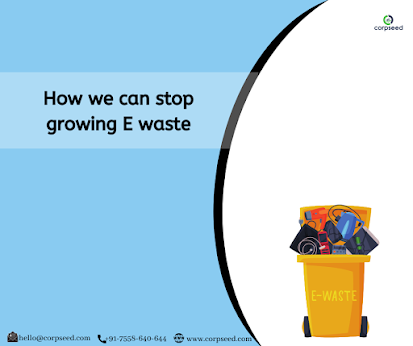How we can stop growing E waste- Corpseed
Electronic waste or e-waste is created when electronic and
electrical equipment becomes useless for their intended use or have crossed the
expiry date. Computers, mainframes, servers, monitors, compact discs (CDs),
printers, calculators, scanners, copiers, fax machines, battery cells, cellular
phones, transceivers, TVs, iPods, medical apparatus, washing machines,
refrigerators, and air conditioners are examples of e-waste (when unfit for
use). These electronic equipment types get fast replaced with newer models due
to the rapid technological advancements and more modern electronic equipment
production. This has led to an exponential expansion in e-waste generation.
People manage to switch over to the newer models, and the life of products has
also reduced.
E-waste typically consists of plastics, metals, cathode ray
tubes (CRTs), printed circuit boards, cables, and so on. Valuable metals such
as copper, gold, silver, and platinum could be obtained from e-waste if
carefully processed. The appearance of toxic materials such as liquid crystal,
lithium, nickel, mercury, polychlorinated biphenyls (PCBs), selenium, arsenic,
barium, brominated flame retardants, chrome, cadmium, cobalt, copper, and lead
makes it very hazardous if e-waste is destroyed and processed crudely with
rudimentary techniques. E-waste poses a significant risk to humans, animals,
and the environment. The appearance of heavy metals and highly poisonous
materials such as mercury, lead, beryllium, and cadmium pose a significant
threat to the ground even in minute amounts.
Consumers are the solution to better control of e-waste.
Leads such as Extended Producer Responsibility (EPR); Design for Environment
(DfE); Reduce, Reuse, Recycle (3Rs), a technology program for linking the
market promoting a circular economy, aim to encourage customers to correctly
dispose of their e-waste, with grown reuse and recycling rates, and adopt
sustainable consumer habits. Ingrown countries, e-waste management, are given
high preference. In contrast, in developing countries, it is exacerbated by
ultimately adopting or replicating developed countries' e-waste
management and several related problems, including a lack of investment and
technically skilled human resources. Also, there is a lack of infrastructure
and the absence of appropriate legislation explicitly trading with e-waste.
Also, there is an incomplete summary of the roles and responsibilities of
stakeholders and institutions involved in e-waste management. In 2016, the
Ministry of Environment, Forest and Climate Change (MoEFCC) issued the updated
E-waste (Management) Rules, which appeared in supersession of the E-waste in
India (GOI, 2016).
Global E-Waste Problem
International treaties such as the Basel Convention aim to
reduce and regulate hazardous waste movement between nations. Even with the
Convention, illegal shipment and dumping of e-waste proceed to take place. It
is expected that 50 million tonnes of e-waste were generated globally in 2018.
Half of this is personal materials such as screens, smartphones, computers,
tablets, and TVs, with the remainder being larger household devices and heating
and cooling equipment. Despite 66 percent of the world’s population remaining
covered by the e-waste act, only 20 percent of global e-waste is reused each
year, which means that 40 million tonnes of e-waste are either burned for
resource recovery or illegally traded and treated in a sub-standard way. More
than 100 million computers are driven away in the US alone, with less than 20
percent being recycled properly. China cuts 160 million electronic devices a
year. In the past, China has been recognized as the biggest e-waste dumping
site in the world. Hundreds of thousands of people have expertise in destroying
electronic junk.
The rate at which the e-waste volume is growing globally is
5 percent to 10 percent annually. In India, the work of e-waste produced was
146,000 tonnes per year (Borthakur and Sinha, 2013). However, those data only
cover e-waste produced nationally and do not involve waste imports (both legal
and illegal), which are substantial in emerging economies such as India and
China. The reason is that large amounts of waste, electrical and electronic
equipment (WEEE) enter India from foreign countries. Switzerland is the first
country in the world to have organized and executed a formal e-waste management
system that has recycled 11 kg/capita of e-waste against the target of 4
kg/capita set by the European Union (EU). Recycle the e waste and for more
information you can contact best legal advisors like corpseed, they will help
you or.
for more information visit https://www.corpseed.com/



Comments
Post a Comment